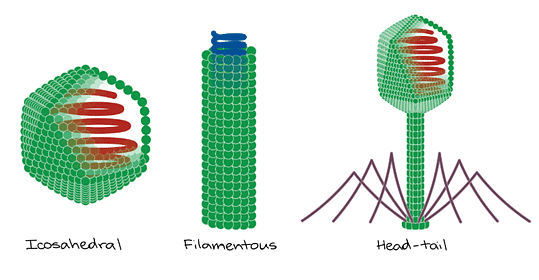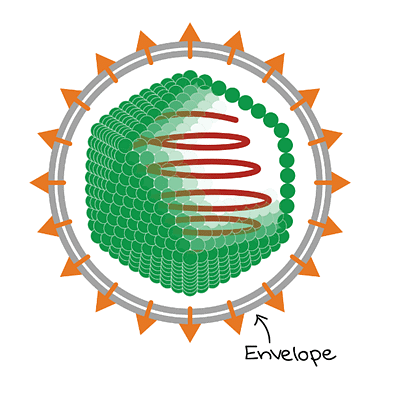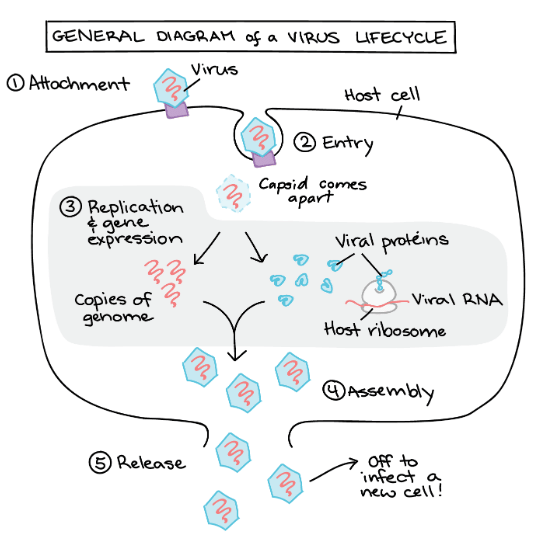Structure and Reproduction in Viruses | Botany Optional for UPSC PDF Download
| Table of contents |

|
| Key points |

|
| What is a virus? |

|
| How are viruses different from bacteria? |

|
| Virus capsids |

|
| What is a viral infection? |

|
Scientists estimate that there are an incredibly vast number of viruses, approximately 1031, which is a one followed by 31 zeroes, present at any given moment. To visualize this quantity, if all these viruses were lined up consecutively, it would extend to a length of nearly 200 light years into space. To put it in perspective, there are more than ten million times more viruses on Earth than there are stars in the entire universe when squared.
However, it's important to note that the majority of these viruses are located in the oceans, where they primarily target bacteria and other microorganisms. This might seem surprising, but scientists believe that virtually every type of living organism likely plays host to at least one virus.
Key points
- A virus is an infectious entity that replicates by taking control of a host cell and utilizing its machinery to produce additional viruses.
- A virus consists of a genetic material, which can be either DNA or RNA, enclosed within a protein coat known as a capsid. Some viruses also possess an external membrane envelope.
- Viruses display significant diversity in terms of their shapes, structures, genetic material, and the organisms they infect.
- The reproduction of viruses involves infecting host cells and altering them to function as facilities for generating new viruses.
What is a virus?
A virus is a minuscule and infectious particle that can only replicate itself by infiltrating a host cell. Viruses essentially take control of the host cell and utilize its resources to produce additional viruses, essentially reprogramming it into a virus-producing factory. Because viruses cannot replicate on their own (without a host), they do not fit the criteria for being classified as living organisms. Viruses also lack cellular structures; they are incredibly tiny, significantly smaller than the cells found in living organisms, and essentially consist of packages containing nucleic acid and protein.
Nevertheless, viruses share several significant characteristics with life forms based on cells. For example, they possess nucleic acid genomes that adhere to the same genetic code used in the cells of all living organisms. Additionally, similar to cell-based life, viruses exhibit genetic diversity and have the capacity to evolve. Consequently, even though viruses do not precisely meet the criteria for life, they exist in a somewhat ambiguous category. It's almost as if viruses could be described as "undead," drawing parallels to concepts like zombies or vampires!
How are viruses different from bacteria?
Viruses and bacteria, despite both having the potential to cause illnesses, exhibit significant biological differences. Bacteria are small, single-celled living organisms that can reproduce independently without relying on a host cell. These distinctions lead to varying approaches in the treatment of bacterial and viral infections. Notably, antibiotics are effective against bacteria but have no impact on viruses.
Moreover, bacteria are substantially larger than viruses. A typical virus has a diameter ranging from 20 to 300 nanometers (1 nanometer = 10-9 meters), which is significantly smaller than the typical E. coli bacterium with a diameter of roughly 1000 nanometers. To put this into perspective, an immense number of viruses could fit on the head of a pin.
The structure of a virus
The structure of viruses can be highly diverse, with significant variations in size, shape, and life processes. To explore this diversity, you can experiment with the ViralZone website by clicking on different virus names to discover their unique shapes and characteristics.
Nevertheless, there are some fundamental characteristics that viruses typically share, including:
- A protective protein shell known as a capsid.
- A nucleic acid genome composed of either DNA or RNA, enclosed within the capsid.
- Some viruses possess an additional outer layer called an envelope, although this feature is not universal among all viruses.
Let's take a closer look at these features:
Virus capsids
The capsid, which is the protective protein shell of a virus, is not a single, large structure but is instead composed of multiple protein molecules. These proteins come together to form units known as capsomers, which collectively create the capsid. It's important to note that the instructions for producing capsid proteins are provided by the virus's own genome, not the host cell's.
Capsids exhibit various shapes, with some common forms being:
- Icosahedral: Icosahedral capsids have twenty faces and are named after the geometric shape called an icosahedron.
- Filamentous: Filamentous capsids resemble long, thin, thread-like structures and may also be referred to as rod-shaped or helical.
- Head-tail: These capsids are somewhat a blend of filamentous and icosahedral shapes, comprising an icosahedral head attached to a filamentous tail.

Virus envelopes
Apart from the capsid, certain viruses possess an outer lipid membrane called an envelope, which encloses the entire capsid.
Viruses with envelopes do not carry the instructions for creating the envelope lipids themselves. Instead, when exiting the host cell, they incorporate a portion of the host cell's membranes into their structure. However, the envelope does contain proteins that are determined by the virus, and these proteins often aid viral particles in attaching to host cells.
While envelopes are prevalent, particularly among viruses that infect animals, it's important to note that they are not a characteristic found in every virus. In other words, envelopes are not universally present in all viruses.
Virus genomes
Every virus possesses genetic material, referred to as a genome, which is composed of nucleic acid. While DNA serves as the genetic material in cell-based life, viruses can utilize either RNA or DNA, both of which belong to the nucleic acid category.
In our cells, DNA is typically double-stranded, and RNA is usually single-stranded. However, viruses can exhibit any combination of strandedness and nucleic acid type, including double-stranded DNA, double-stranded RNA, single-stranded DNA, or single-stranded RNA. Viral genomes also exhibit a wide range of sizes, shapes, and variations, although they are generally much smaller compared to the genomes found in cellular organisms.
Importantly, DNA and RNA viruses always adhere to the same genetic code as living cells. This adherence is crucial because it enables viruses to reprogram their host cells effectively.
What is a viral infection?
In our everyday experience, a viral infection is what we typically associate with the unpleasant symptoms we experience when we contract a virus like the flu or chickenpox. However, let's delve into what actually occurs within your body during a viral infection.
At the microscopic level, a viral infection entails numerous viruses exploiting your cells to replicate and produce more copies of themselves. The viral lifecycle comprises a series of steps in which a virus first identifies and enters a host cell. It then effectively "reprograms" the host cell by providing instructions in the form of viral DNA or RNA. Subsequently, the virus harnesses the host's resources to generate additional virus particles, essentially running a viral "program."
For a typical virus, this lifecycle can be broken down into five primary steps, although the specifics can vary for each virus:
- Attachment: The virus recognizes and attaches itself to a receptor on the surface of a host cell.
- Entry: The virus gains entry into the cell, often through a process like endocytosis. Once inside the cell's cytoplasm, the capsid (protective protein shell) disassembles, releasing the viral RNA or DNA.
- Replication and Gene Expression: The viral RNA or DNA is copied (usually with the assistance of viral enzymes) and translated into viral proteins by using the host's ribosomes. These produced viral proteins include capsid proteins.
- Assembly: Capsid proteins combine with RNA or DNA genomes to form new viral particles.
- Release: The infected cell eventually bursts or lyses, releasing the newly formed viral particles into the surrounding environment. These released particles can then proceed to infect other host cells.
In essence, a viral infection involves a highly orchestrated process where viruses co-opt your cells to reproduce and propagate.
|
179 videos|143 docs
|





















